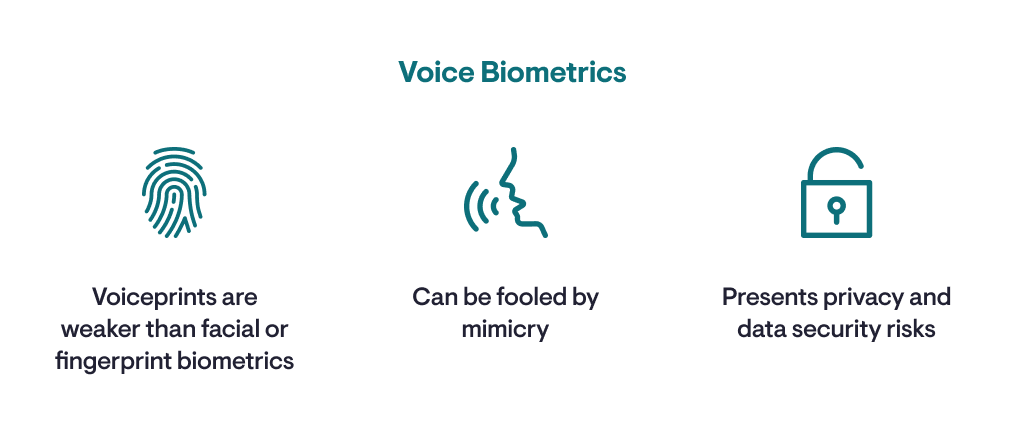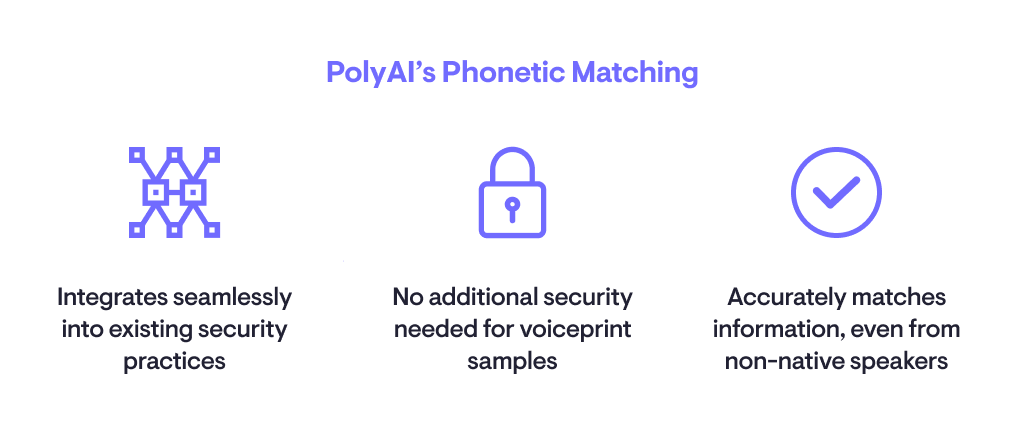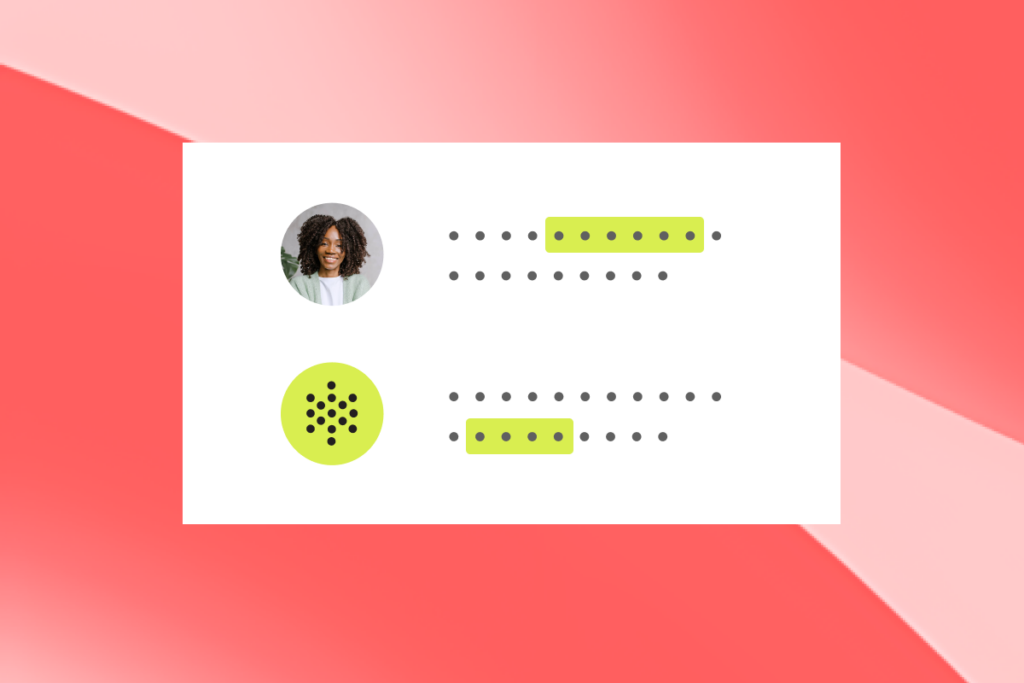Language is full of characters and words that sound frustratingly similar. Sorry, was that M or N? Did you say three, free, or tree? In normal conversation amongst friends, this is easily overcome, but customers are less forgiving when they have an issue with a product or service.
Before customers even get the opportunity to unload the burden of their problems, they are usually waiting on hold longer than they would like, only to then constantly repeat themselves just to get past the caller verification step. Research by the Harvard Business School has shown that added effort can reduce customer loyalty over time.
Call center identity verification is a prerequisite for introducing more personalised customer service and better self-service options. Countless hours are currently spent by customers waiting on hold for the next available agent to verify their identity.
Similar phonetic sounds, combined with background noise, accents, and call quality make caller authentication a difficult task for even the most skilled call centre agents. It’s a repetitive and thankless part of their job: no-one ever left a positive review for being correctly authenticated, but customers won’t hesitate to leave a negative review if asked to repeat themselves too often.
What is voice biometrics?
Voice biometrics, also known as voice recognition or speaker recognition, is a technology that uses an individual’s voice to verify their identity. It is often used by contact centers to authenticate user identity during customer service calls.
Voice recognition biometrics analyzes various characteristics of a person’s voice, including pitch, tone, cadence, and vocal traits, to create a unique voiceprint or voice model (much like a fingerprint!)
Some voice authentication solutions require customers to say a specific passphrase, such as “My voice is my password”. Others can seamlessly identify customers based solely on natural, real-time conversation and in many cases without customers even realizing it!
Why voice biometrics is vulnerable (and how it threatens security)
Voice biometrics is one way to get around the repetitive nature of caller authentication. These solutions use a complex understanding of vocal tracts, pitch, and nasal passages to create a ‘voiceprint’ using samples of each person’s voice.
However, this method introduces new security challenges.

The risk of shifting security concerns
Voice biometrics shift security risks from safeguarding personal information to ensuring the security of the voice biometrics software itself. This creates new vulnerabilities that organizations must address.
Many businesses believe that by using voice biometrics, they can reduce the repetitive nature of caller authentication. These systems analyze vocal tracts, pitch, and nasal passages to create a unique ‘voiceprint’ for each user. However, the underlying risk isn’t eliminated; it is merely transferred.
Instead of focusing on how customers protect their personal information, the focus shifts to securing the voice biometric software.
Comparative weaknesses to other biometrics
Industry experts see voiceprints as weaker than facial or fingerprint biometrics. The BBC has already demonstrated that voice biometrics can be fooled by mimicry.
Consent and compliance issues
The need for explicit consent from customers to use voice biometrics also creates new risks for customer experience, privacy and data security. HMRC (the UK’s taxation authority) was forced to delete 5 million voice recordings after its voice biometrics solution was found to have breached data protection rules.
The need for multi-factor authentication
It’s an unfortunate reality that in our brave new world no software can be 100% secure. While voice biometrics can be part of a robust security strategy, relying on it alone is insufficient.
That’s why organisations need to use multiple authentication methods, such as facial recognition, passwords, etc.
How PolyAI re-invented the voice biometrics authentication wheel
At PolyAI, we have pioneered a new approach for customer-led voice assistants to authenticate customer information in conversation: phonetic matching. We combined our deep expertise in speech recognition systems with a complex understanding of vocal tracts to help our voice assistants match alphanumeric information with unparalleled precision.

Put simply, our voice assistants can authenticate account information such as a customer’s name, address, and date of birth with up to 95% accuracy in the flow of conversation before any additional training.
You can see PolyAI in action right now! Check out how John was prompted to confirm his account information before receiving support for his billing query:
Authentication using natural conversation means our voice assistants fit seamlessly into the existing security practices of call centres. There is no requirement for individual voice samples and no additional considerations around the privacy and security of those samples. This results in an effortless user authentication experience that customers and organizations can get behind.
Unlock the benefits of PolyAI’s phonetic matching
Experience the advanced capabilities of PolyAI’s phonetic matching technology. Our solution seamlessly integrates with your existing security measures and eliminates the need for additional security for voiceprint samples. It ensures accurate information matching, even for non-native speakers, to enhance the customer experience.
A focus on phonetic sounds also enables our solution to accurately match information such as the name Tsung-Hsien Wen (our CTO), overcoming previous barriers in the customer experience of non-native speakers in different languages.
Phonetic matching creates a robust and scalable new authentication method that will complement existing account security measures. It will also remove a significant but repetitive and thankless workload from the call center, freeing agents up to focus on value-added problem-solving and personalizing the experience for each caller. Customers will be able to effortlessly verify their identity while waiting for the next available agent, or better yet, they’ll be able to proceed directly to resolve their issue with a voice assistant without any wait time at all.
Accurate caller verification has long been a barrier to better personalization and self-service for customers. With PolyAI’s phonetic matching approach, we believe organizations are closer than ever to robust voice assistants that can be trusted with this important task at scale.
Voice biometrics FAQs
You’ll find answers to some of the most frequently asked voice biometrics questions below.
What is the difference between conversational ID&V and voice biometrics?
Conversational identity verification (ID&V) and voice biometrics are both methods used to verify the identity of a person, but they operate in different ways and are used in different contexts. Here’s a breakdown of their differences:
- Conversational ID&V uses natural conversation and contextual understanding to verify identity, making it user-friendly and flexible for various interactions but dependent on advanced NLP capabilities.
- Voice biometrics is a system that uses the unique characteristics of a person’s voice for authentication, offering high security and efficiency but requiring high-quality voice samples and potentially facing issues with voice changes or mimicry.
Both methods can be used independently or together to enhance security and user experience in automating identity verification processes.
In what situations is voice recognition biometrics typically used?
Voice biometrics are commonly used in call centers for customer authentication processes, secure access systems for logging into accounts, and authorizing transactions, and even in mobile applications for verifying user identity.
Is voice biometrics the same as speech recognition?
No, voice biometrics and speech recognition are not the same.
Voice biometrics focuses on identifying and verifying a person based on their unique vocal characteristics.
In contrast, speech recognition is about understanding and processing the spoken words regardless of the speaker.
Voice biometrics ensures secure and personalized authentication, while speech recognition aids in interpreting and responding to verbal commands. Both technologies can complement each other in enhancing customer service experiences.




